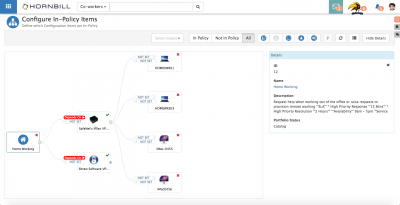Configuration Item Explorer
Home > Configuration Manager (Beta) > Configuration Item Explorer
IntroductionThe CI Explorer provides a graphical representation of associated or linked CIs. The explorer can be launched from within the Configuration Manager app, or from other views where the Configuration App plug in is available. Typically this would be from Configuration Item views, such as Service records, or Request records. The Explorer can be used to view and define relationships between Configuration Items. |
Related Articles |
Features
Explorer Expansion
By Default the explorer is set to expand to a maximum of 3 levels, but this can be configured in the admin tool under Home > Configuration Manager > Applications Settings and the app.cm.explorer.diagram.level.max system setting
In Policy
Show all CI's, those in or out of Policy
Relationship Definitions
Define bi-directional relationships between CI's by setting the relationship type and level of impact by selecting form the relationship types and impact levels.
- Dependancy on the Parent
- Dependancy from the Parent
The available relationship types can be set differently depending on the direction of the relationships, and be different depending on the type of CI's being connected. These options can be configured in the admin tool under Home > Configuration Manager > Application Settings and the app.cm.explorer.items.dependencies system setting.
Impact Relationship Visibility
Filter the displayed CI's by level of impact. By default All will be visible, but filter this to only show Relationships which are marked as High, Medium or Low Impact
CI Visibility
Choose which CI types are displayed on the Explorer by enabling or disabling them from the menu control. By default Assets, Requests, Documents, Users, Services will be visible.
- Set Current Node as Root: When viewing the Details of a CI from another CI, use the option from the menu to Set Current Node as Root. This will reset the explorer view using this CI as the Root.
- Details: Click on the name of the CI to see it's information displayed in the Details section on the explorer. Select the Title of the CI from the Details section to open the CI in a new tab
